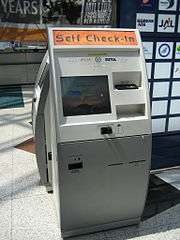Common-use self-service

Common-use self-service or CUSS is a shared kiosk offering airport check-in to passengers without the need for ground staff. The CUSS can be used by several participating airlines in a single terminal.[1]
The first major installation of CUSS for multiple airlines was launched in 2003 in a cooperative project between LAS McCarran Airport, ARINC and twelve participating airlines. By the end of 2008, CUSS had been implemented at more than 100 airports globally.[1]
Benefits
Passengers
Passengers can enjoy easier and faster passage through the airport, due to less queues. Furthermore, CUSS kiosks can be located throughout the airport,[1] ranging from car parks to transit areas, thus cutting down airport crowds.[2]
Airline and airports
Economically, CUSS reduces the labour cost of ground staff required by manual check-in. With the introduction of CUSS, the check-in area at the airport can be reduced to enable more retail outlets, or entertainment facilities. Based on IATA studies, a 40% market penetration of self-service check-in will save $US1 billion per year.. CUSS can be implemented in the cloud, optimising resource usage and support overheads, that eliminates the need for servers, core computing space and costly technical manpower[3].
References
- 1 2 3 "Common Use Self-Service (CUSS)". International Air Transport Association. Retrieved 21 February 2014.
- ↑ Ticketing Kiosks. Kiosks Inc; February 2014 [cited 21 February 2014].
- ↑ Administrator. "Common Use Check-In | Leading Check In System | ARINC Airports". www.airportknowledge.com. Retrieved 2017-12-22.